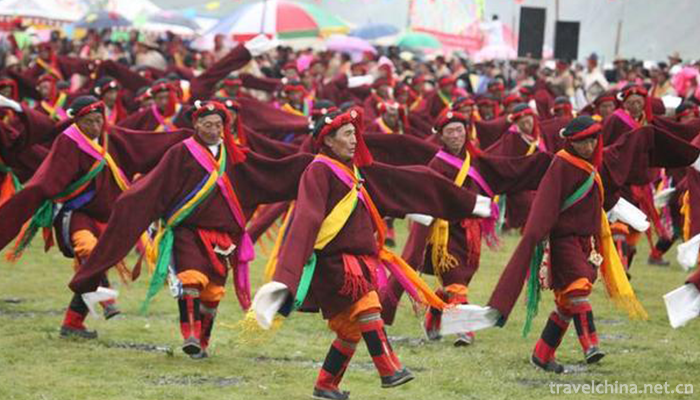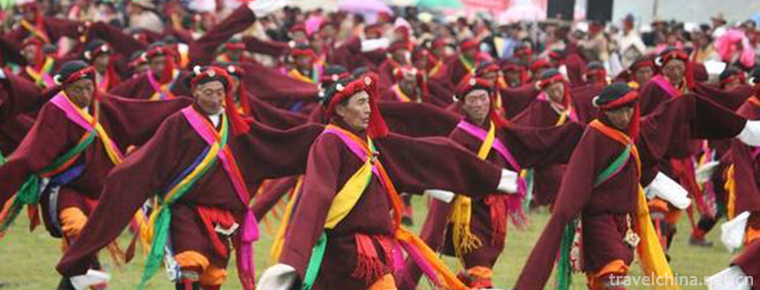Guwo Yushu Samurai Dance
Guwo Yushu Samurai Dance
Samurai dance is a unique style of etiquette folk dance spread in Yushu. It is called Guowa (or Guowa) in Tibetan. Guo refers to weapons in Tibetan. It means warriors with weapons. Wo refers to dancers who perform in important ritual occasions of temples and tribal people.
Historical origin
Historically, Yushu is a famous town of "Tang-Fan Ancient Road". When Princess Wencheng entered Tibet in the seventh century A.D., she had a magnificent journey of "flag display, ceremony opening, magnificence". She stayed here for a long time through Yushu, while resting her whole horse, training soldiers and spreading the original production technology. The princess also sent people to carve a Buddha statue and eight Bodhisattvas statues on the rocks of Beku, Yushu, and built a temple. The opening ceremony was held. The temple was named "Da Ri Tathagata Temple". It was worshipped by the local people. So far, the incense is very strong and the believers are endless.
The princess's entrance to Tibet has played a certain role in promoting the development of Tibetan culture and economy. This kind of honor guard and soldier drill in the Central Plains has been absorbed by the local Ben religion and become the ritual beach of Ben religion. Ben religion is the Tibetan primitive religion. Its main feature is a variety of worship. All things are spiritual. Samurai dance is an important part of Ben sacrificial activities.
When Princess Wencheng entered Tibet, Ben religion was still the state religion of the Tubo Dynasty. The struggle between Buddhism and Benzene had not yet become white-hot. Ben religion, in order to consolidate its dominant position, used the form of ceremonial guard in the Central Plains to strengthen and propagate its doctrine in sacrificial ceremonies.
For example, when performing a warrior dance, the first to appear is a number of warriors, who shoot and shout in order to worship the gods and clean the venue. This kind of shouting guns and shouts are common in Tibetan sacrificial activities. Next came the Tibetan flag and the music of Okingling, Sigu and Rao. Then two rows of warriors with crossbows and swords stepped out slowly and stepped on the music. This was very similar to the situation of Princess Wencheng entering Tibet described in the History of Da Ri Tathagata Temple. It was also similar to the murals of princesses entering Tibet in Tibetan temples we saw. It can be seen that the performance form of samurai dance was indeed influenced by the original Chinese language. Influences of chemical and benzene teaching stalls.
Spiritual meaning
Tibetans are fascinated by the worship of Buddhism, and Buddhism permeates the whole life of Tibetans. Yushu people think that performing Guowa is "God and I are happy together", and it also contains a kind of dignity, praise and perfection, which is the embodiment of self-spirit. Samurai dancers are adult men. They must be devout native people. It is forbidden to impart knowledge to others and women to sing and perform. Otherwise, they are impure to God.
Guowa's performance time must be selected for a specific day, time and star. Everyone not only enthusiastically participates, but also wears the most luxurious clothes in order to be auspicious. Dancers wear high eaves, red spikes, jewelry and jade hanging at the neck, wearing brocade silk ribbon, waist knife, brocade and satin clothes with black and white matching otter skin edge, appear noble, elegant, dignified, this is the highest etiquette dress of Yushu men.
Dance characteristics
Collective large-scale dance, the number of performers is unlimited, generally more than 40 people. Because the participants are middle-aged and old people, with luxurious clothes, solemn music and simple movements, they are dignified, solemn and mysterious.
From the appearance to the end of the dance, the choreography is rigorous, breaking the single change of the traditional folk dance troupe, and combining the ritual of "Yitan" exorcising ghosts and Demons and eliminating disasters with the content of ancient military exercises. Musical instruments with big drums, big rao, big trumpet, magnificent momentum, majestic. Dance emphasizes strength and momentum, calm and steady, bold and stretching.
The formation of warrior dance, no matter how long, as an early folk sacrificial and ritual dance, is very successful in both art and thought. It is a wonderful flower in the early Tibetan folk songs and dances, from which we can see the early Tibetan multi-cultural exchanges and fusion, but also the new era of Qinghai Yushu fresh cultural card.


-
1.Jiang Cudan Canton style pig leg
Except for those with internal fever, dry stool and weak spleen and stomach function, breast enlargement products can be used as a warm-up tonic in winter.
Time 2018-11-02 -
2.Longkou Nanshan Scenic Area
Nanshan tourist scenic spot is located in the beautiful scenery of Lu Shan in Longkou City, Yantai City, Shandong province. The scenic spots of Nanshan Temple
Time 2018-12-08 -
3.Xianguding Scenic Spot
Xianguding, located in the south of Huancui District, Weihai City, is only five kilometers away from the city centre. It is the highest peak in the Northwest Mountain of Wangdao, with an elevation of
Time 2018-12-22 -
4.Li Zhuang ancient town
Lizhuang, an ancient town precipitated by cultural and historical relics, is an ancient town that tells stories and vicissitudes of the Anti-Japanese War. It is an ancient town that reflects Chinese t
Time 2019-01-29 -
5.Iron flower
Tiehua is a kind of fireworks which spread in the folk traditions of Henan and Jin Dynasties. It has a long history which can be traced back to the Spring and Autumn Period and the Warring States Peri
Time 2019-04-23 -
6.Lishui drum words
Lishui Drum Ci is a popular rap art in Liandu and its surrounding areas in Lishui City, Zhejiang Province. Lishui Drum Ci originated from the Tang Dynasty. During the reign of Emperor Li Shimin, it wa
Time 2019-05-13 -
7.Pingyao Shage Player
Pingyao Shage Opera, commonly known as Shage Renren, also referred to as Shage, is one of the traditional handicraft techniques in Pingyao, Shanxi Province. Because it was usually placed in the cabine
Time 2019-06-09 -
8.kylin dance
Kirin dance, also known as "Wu" Kirin, is a court dance performance of the Ming Dynasty in China. It was spread among the people when the Nanming Dynasty perished. When dancing,
Time 2019-06-10 -
9.Qiang sheepskin drum
Sheepskin drum dance, known as "Monasha", "Moldasha" or "Buzila" in Qiang language, is a kind of sacrificial dance performed by "Shibi" in legal activities, als
Time 2019-06-10 -
10.Uygur Dastan
Uygur Dastan is a kind of Uygur singing and playing music. It is a kind of long narrative poem with rap and singing. It is a long poem with complete stories and characters. It is a folk art form with
Time 2019-06-26 -
11.Sintering Techniques of Xingyao Ceramics
Xingyao firing technology is a local traditional handicraft in Hebei Province. Xing kiln is a famous northern kiln in China. As early as the Northern Dynasty, Xing kiln began firing celadon and a smal
Time 2019-07-08 -
12.Zao Bang
Zaobao is one of the traditional local operas in Shandong Province. It is mainly popular in Heze, Yuncheng, Liangshan, Juye, Juye, Juancheng and Dingtao. It developed under the influence of local lang
Time 2019-07-16